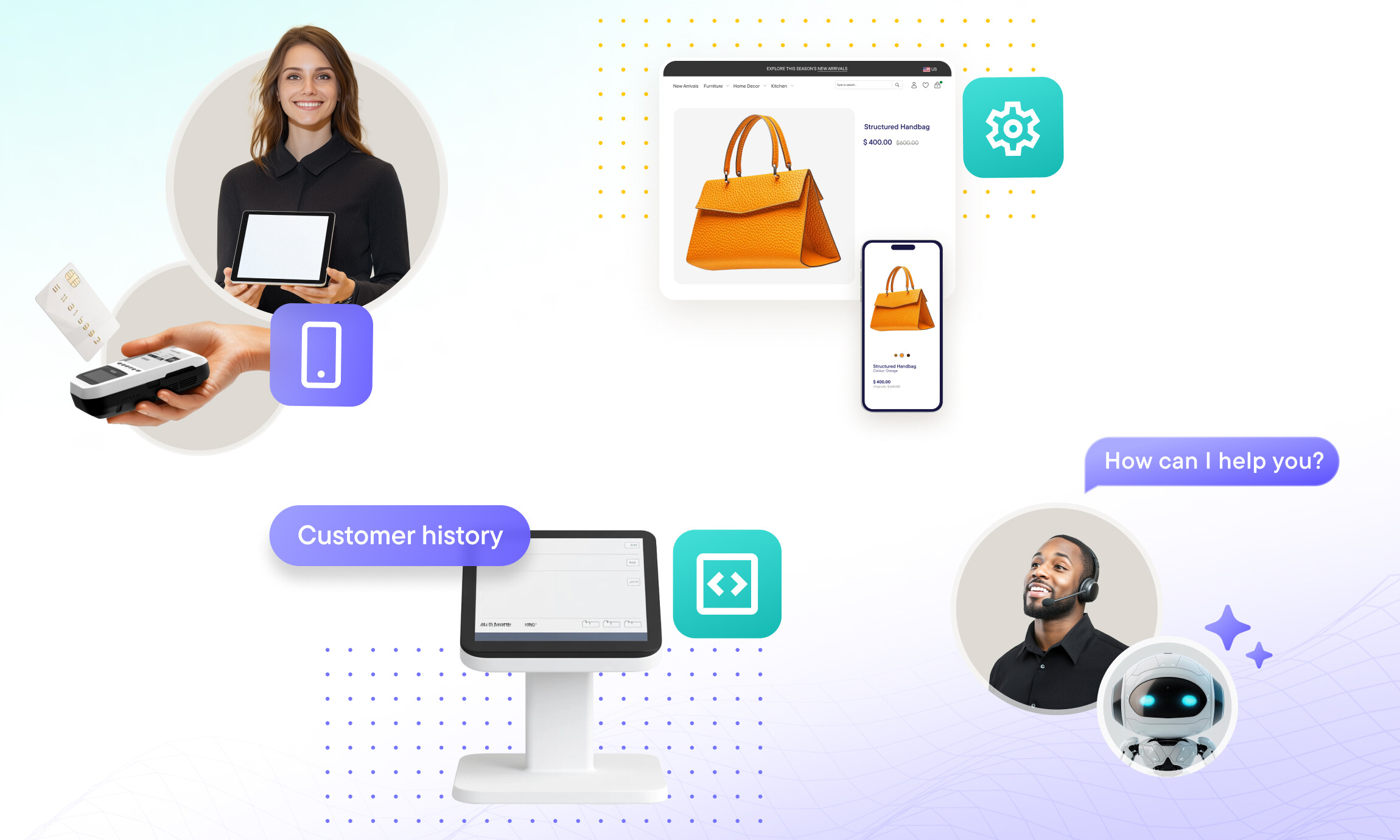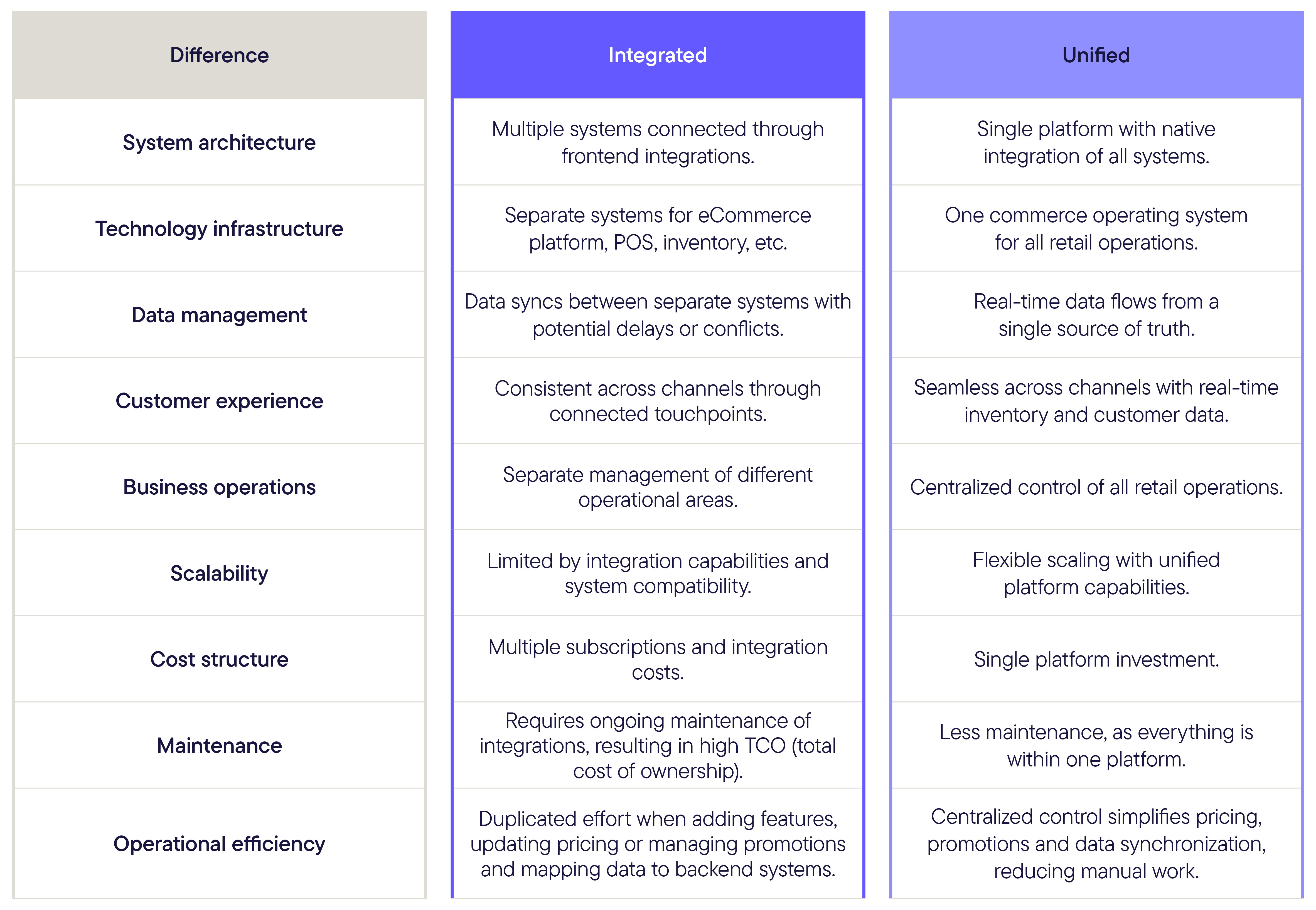
Integrated commerce connects channels, but unified commerce creates a seamless experience. Learn why unification is the key to better customer engagement, operational efficiency and higher revenue in today’s omnichannel world.

Today’s shoppers don’t think in channels — they see a brand. They expect to browse online, buy in-store and return via an app without friction. For retailers, this means seamlessly blending physical and digital commerce.
And the numbers prove it:
73% of consumers use multiple channels in their shopping journey.¹
Multi-channel shoppers spend 15% more per order and have 70% higher retention rates.²
Retailers who unify their physical and online operations see significantly higher efficiency and growth.³
The challenge isn’t just being present on multiple channels — it’s ensuring they work together in real time. That’s where integrated commerce and unified commerce come in. While both aim to connect the shopping experience, only one truly eliminates silos, syncs data in instantly and delivers a seamless journey. Which one wins? Let’s dive in.
What is integrated commerce?
Integrated commerce allows for omnichannel experiences by connecting separate systems — eCommerce, POS, CRM and inventory — via APIs, middleware or third-party integrations. It enables businesses to offer personalized experiences at each touchpoint, but the underlying infrastructure remains fragmented. While this can work, the cracks start to show when real-time data fails to sync, leading to frustrating gaps in inventory visibility, order management and customer interactions.
Only 17% of retailers say they have high unified commerce maturity, even though 38% claim their transformation is in advanced stages and a staggering 64% admit to critical gaps in their core commerce capabilities.² These gaps often stem from the complexity of maintaining an integrated system that wasn’t built to function as a single source of truth (aka unified commerce).
Key limitations of integrated commerce:
Data synchronization challenges: Separate systems require constant syncing, often leading to delayed or inaccurate information.
Higher operational costs: Managing multiple platforms and maintaining integrations increases expenses.
Disjointed customer experiences: Personalization and seamless transitions between channels are difficult to maintain.
No real-time visibility: Inventory and customer data updates are often lagging, impacting order fulfillment and demand forecasting.
Picture a restaurant where the kitchen, waitstaff and payment systems all operate independently. Orders might get to the kitchen, but without real-time coordination, ingredients could run out, meals might be delayed and diners would have an inconsistent experience. That’s how integrated commerce works — the systems are connected, but not truly unified, leading to inefficiencies and gaps in the customer journey.
Why retailers are moving toward unified commerce
Unified commerce goes beyond simply connecting channels — it creates a single source of truth across sales, operations and customer data. Rather than patching together multiple systems, unified commerce operates on one centralized platform, eliminating data silos and ensuring real-time updates across all touchpoints.
Key advantages of unified commerce:
Scalability: Retailers can expand without the complexity of managing integrations.
Operational efficiency and cost reduction: A single system reduces redundant processes, leading to lower operational costs.
Seamless customer experiences: Real-time data ensures customers receive consistent, personalized interactions, whether shopping online or in-store.
Meanwhile, retailers with high unified commerce maturity report 23% higher inventory turnover and 22% lower customer acquisition costs,² reinforcing the fact that a centralized, real-time approach isn’t just more efficient — it’s a competitive advantage. The question for retailers isn’t whether they should connect their systems, but how seamlessly those systems should function together to create a frictionless customer experience.
Key differences between integrated and unified commerce
While both integrated and unified commerce aim to enhance omnichannel experiences, they differ in structure and execution. Below is a direct comparison of the two:

Achieving unified commerce with commercetools InStore
For retailers looking to break down the barriers between digital and physical shopping, commercetools InStore is the cutting-edge innovation they’ve been waiting for. By centralizing customer, order and inventory data in real time, it eliminates outdated silos and ensures that every touchpoint — whether online, mobile or in-store — works in perfect harmony.
Legacy in-store systems are notorious for being rigid, slow and expensive to maintain. commercetools InStore flips the script with a composable, API-first approach that gives retailers the agility to evolve at the speed of consumer expectations. Think real-time inventory tracking, frictionless buy-online-pick-up-in-store (BOPIS) and omnichannel returns — capabilities that 57% of consumers now expect as standard.³
Despite the rise of eCommerce, physical retail is far from dead — 72% of retail sales are still projected to happen in stores through 2028.⁴ The challenge? Customers demand the same seamless, personalized experience they get online when they walk into a store. And yet, outdated POS systems often make that impossible. Imagine walking into a store, asking an associate for help and being told they need to leave the floor just to check inventory — when you could have done it yourself on your phone.
That’s why 90% of shoppers leave empty-handed if they can’t get assistance, while 93% are more likely to buy when helped by a knowledgeable associate.⁵ commercetools InStore empowers retailers to bridge this gap by equipping associates with intuitive tools, real-time inventory insights and customer purchase history. The result? Higher conversions, better service and a sales productivity boost of 15% for retailers that integrate online and in-store systems.⁶
Jaycar finds success with commercetools InStore
electronics and DIY components. Store associates lacked real-time product visibility, often leaving customers waiting while they checked desktop systems at the front of the store. Meanwhile, online shoppers had access to better search and product recommendations than in-store customers.
By adopting commercetools InStore alongside commercetools B2C Commerce, Jaycar unified all customer interactions into a single platform. In-store teams were equipped with mobile Honeywell PDA tablets and fixed HP terminals, giving them full access to real-time inventory, customer purchase history, loyalty points and omnichannel transactions — right at their fingertips.
The results were transformative: Jaycar rolled out its new in-store commerce engine, along with ratings, reviews and loyalty features, in just seven weeks. Associates now provide customers with real-time stock levels, personalized product recommendations and seamless online-to-offline shopping experiences. No more disconnected workflows or frustrated customers. Jaycar’s success is a testament to how commercetools InStore enables retailers to break free from outdated systems, stay ahead of trends and create frictionless, future-proof shopping experiences.
The future of commerce is unified
As retail continues to evolve, businesses need more than just connected systems — they need a truly unified approach. The rise of AI-driven automation, advanced APIs and composable commerce is making it easier than ever to bring every channel together into a seamless, real-time experience.
The takeaway? Retailers who fully unify their digital and physical commerce — not just integrate — will gain a huge competitive edge with operational efficiency and delighting customers.
Want to see how commercetools Instore can help you achieve unified commerce? Contact us to learn more.
Sources: 1 Porch Group Media, 2 Incisiv, 3 EY, 4Forrester, 5TimeTrade, 6Aberdeen Group
